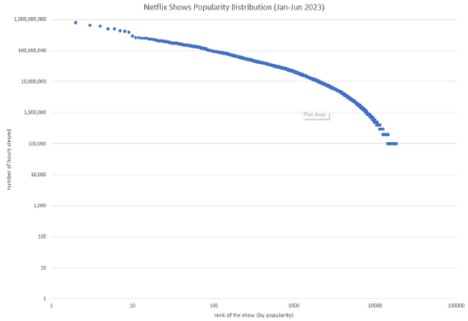There has been an on-going debate about the benefit of caching at the edge. For most operator networks, it can be costly to deploy servers at the edge without a clear demonstration of value. Consider the answer to the question, “will I get enough improvement by putting caches at the edge to outweigh the increased cost versus keeping them closer to the CDNs at the peering points?” What’s been lacking is the data to definitively show one way is better than the other.
Thankfully, at the end of 2023, , we got great announcements for 2 implementers of edge caching. The first was from Netflix (they have their own edge cache, Open Connect, that they provide to operator networks) while the second was from Verizon (a trailblazer on the ISP side for the SVTA’s Open Caching). Together, the data points from these two providers clearly quantifies the benefits of an edge cache deployment for both cost and performance.
Netflix Open Connect
Netflix’s recently published viewership numbers can be used, along with some other data, to build a cost model which clearly shows how edge caches can reduce the overall caching footprint, saving considerable money.
The Numbers
On December 12th 2023, Netflix, for the first time, published viewer data about the popularity of its content–what titles viewers were watching the most (reported in hours viewed). , from which we can derive some conclusions. Let us see how we can interpret those data.
The Netflix report covered 18,000 titles and 100 billion hours viewed from January to June 2023.
To put these numbers into some context, let’s look at some context. SVOD libraries can have a significantly long (and steep) tail. As I wrote about on LinkedIn, most of the content views in any SVOD library are concentrated on a very small percentage of the library
Now, let’s look at the published Netflix numbers. For the time period in the published report,, the numbers show 4% of the titles (movies, documentaries, and series) represents 50% of the views.
(The graph above, prepared by Gwendal Simon of Synamedia, plots the data from the Netflix report as “Number of Views” against “Show Rank (by popularity)”)
Nokia has reported that in Europe, 63% of the Netflix traffic in a large EU country is coming from Open Connect caches located inside of the ISP. With the Netflix number provided, this represents 7% of Netflix library, or 1272 titles.
In addition to that, Netflix has been releasing the audience for the top 10 tiles per country (). I will report on the US numbers, you can look for your own country, and we can see a huge difference between the maximum number of views on the top 10 and the minimum one with a difference of a factor of 15. What does this mean for caching? In short, because caches have a finite footprint to fan out to, if caches are dimensioned for an average traffic, at peak times, 87% more resources need to be provisioned to meet the demand. This means that longer tail content will need to be migrated off-net Open Connect caches.
Building a Model
With the parameters we have–library size, viewing tail, and viewing elasticity–we can create a model, using the technical details of the streams themselves, to help make the case for edge caching. For the purposes of this model, we will assume the following stream parameters: :
- HD AVC 1080p top profile encoding rate: 4M/s average
- UHD HEC 2160 HDR top profile encoding rate: 4M/s average
- ABR to SBR size increase: 3x
- UHD over HD library: 20%
We assume all edge caches are deployed inside ISPs’ POPs and that central caches are shared at a central peering point for all ISPs in the same country, with an N+1 redundancy scheme.
If we take Netflix’s Open Caching Appliance technical details–340 TB of storage and 96 G/s usable I/O–and try to calculate the storage and I/O requirement for a large size European country like France that has 10M Netflix subscribers, shared across 4 ISPs, we can calculate the benefits afforded with edge caching.
Based on the different parameters enumerated before, we can calculate the following caching needs for Netflix content:
- For storage, 120 edge caches, 3 central caches
- For streaming 60 edge caches, 211 central caches.
These values are important for predicting the scalability of the caching system. If we project a near future with 1 T/s I/O capability for caching appliances, as already demonstrated by SVTA members (Broadpeak, Varnish, Intel), the streaming server count could be reduced by 10x, same for the central servers.
In the same way a denser storage could easily increase the size of the storage to 720 TB, which would bring the total server count to:
- For edge caches, 60 servers, 15 per ISP
- For central caches, 3 servers, shared between every ISPs.
Based upon this model, the Open Connect caching needed for a large sized European country to support the entire Netflix SVOD library would be 60 edge caches and 3 central caches.
These modeled projections are very useful for companies looking at caching tier-1 SVOD content requested by their broadband subscribers. By better understanding the relative infrastructure costs associated with caching this content, the case can be made to embrace edge caching whether that is Open Connect or SVTA Open Caching. But improved costs are not the only benefit as evidenced by the published Open Caching performance data from Verizon.
Verizon Open Caching
Verizon’s recently publicized data of SVTA Open Caching nodes within their edge network demonstrates the improved performance of edge caching.
Jeffrey Budney (SVTA board member, Verizon) gave a presentation on October 23rd, at the NANOG 89 conference, releasing production traffic performance data of its deployed Open Caching infrastructure (Verizon’s Open Caching system is provided by Qwilt). This is the first official release by an ISP, that has deployed an Open Caching system, of performance data from production traffic. Note that the values are percentage improvements over non-Open Caching nodes::
- Buffering: 54%
- Video start failures: 63%
- Play failure after start: 48%
- Exit before video start: 95%
- HD performance (average): 7%
There are a couple of reasons for the performance improvement. First is that these Open Caching nodes are located deep inside the ISP network.
No details were provided regarding the scale of the deployment at Verizon, but the model we have developed for Netflix in the previous section could very well be applied to Verizon.
Conclusion
Through this small tour of the Edge Caching, we could provide on one hand some real numbers with Netflix on how content popularity can impact the caching architecture and on the other hand with the Verizon example to have to real life numbers on QoE metric deploying an Edge caching infrastructure based on Open Caching.
It has to be noted that companies mentioned in this article: Broadpeak, Synamedia, Varnish, Intel, Verizon, Qwilt are all active members of SVTA.
-
Jason Thibeault
-
Jason Thibeault
-
Jason Thibeault
How do you make your streaming viewers happier, so they consume more content and keep…





